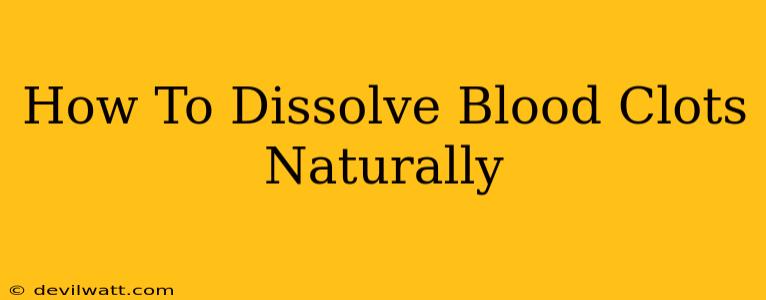Blood clots, while a natural part of the body's healing process, can become dangerous when they form unexpectedly or travel to vital organs. While medical intervention is crucial for serious cases, exploring natural ways to support healthy blood flow and potentially reduce the risk of clot formation can be beneficial. It's vital to understand that this information is for educational purposes only and should not replace professional medical advice. Always consult your doctor before making any changes to your treatment plan.
Understanding Blood Clots
Before diving into natural approaches, let's briefly understand blood clots. They form when blood thickens and clumps together, often due to injury or underlying health conditions. Deep vein thrombosis (DVT) and pulmonary embolism (PE) are serious examples of blood clots that require immediate medical attention.
Factors that Contribute to Blood Clot Formation:
- Genetics: Family history of blood clotting disorders can increase your risk.
- Lifestyle: Lack of exercise, smoking, obesity, and prolonged periods of immobility are significant risk factors.
- Underlying Health Conditions: Conditions like cancer, heart disease, and pregnancy can increase the likelihood of clot formation.
- Medications: Some medications can increase the risk of blood clots.
- Surgery or Injury: Trauma or surgery can trigger blood clot development.
Natural Ways to Support Healthy Blood Flow
While these methods cannot dissolve existing dangerous clots, they may support overall circulatory health and potentially reduce the risk of future clot formation. Always consult your doctor before trying any of these approaches.
1. Hydration is Key:
Drinking plenty of water is crucial for maintaining healthy blood viscosity. Dehydration can thicken your blood, increasing clot risk. Aim for at least 8 glasses of water daily.
2. The Power of Nattokinase:
Nattokinase is an enzyme derived from fermented soybeans (natto). Some studies suggest it may possess fibrinolytic properties, meaning it could help break down blood clots. However, more research is needed to confirm its efficacy and safety.
3. Embrace Movement:
Regular physical activity significantly reduces the risk of blood clots, particularly DVT. Aim for at least 30 minutes of moderate-intensity exercise most days of the week. Even simple activities like walking can make a difference.
4. Dietary Adjustments:
- Increase your intake of foods rich in Vitamin K: Leafy greens, broccoli, and Brussels sprouts are good sources. Vitamin K plays a role in blood clotting, but maintaining appropriate levels is key.
- Consume foods rich in Omega-3 fatty acids: Fatty fish like salmon, mackerel, and tuna are excellent sources. Omega-3s have anti-inflammatory properties that may support healthy blood flow.
- Limit saturated and trans fats: These fats can contribute to blood thickening.
- Eat a diet rich in fiber: Fiber can improve overall cardiovascular health.
5. Herbal Remedies (Consult Your Doctor First!):
Some herbal remedies, such as turmeric (curcumin) and ginger, have shown anti-inflammatory and anticoagulant properties in some studies. However, their effectiveness in dissolving blood clots is not definitively established, and they can interact with medications. Always consult your doctor before using herbal remedies, especially if you are taking other medications.
When to Seek Immediate Medical Attention
Do not attempt to self-treat a suspected blood clot. Symptoms of a dangerous blood clot can include:
- Sudden chest pain or shortness of breath: This could indicate a pulmonary embolism (PE).
- Swelling, pain, or tenderness in one leg: This could be a sign of deep vein thrombosis (DVT).
- Sudden severe headache or dizziness: These could be signs of a clot in the brain.
If you experience any of these symptoms, seek immediate medical attention. Early diagnosis and treatment are crucial for preventing life-threatening complications.
Disclaimer: This article is for informational purposes only and does not constitute medical advice. Always consult with a qualified healthcare professional before making any decisions related to your health or treatment. The information provided here should not be considered a substitute for professional medical care.

